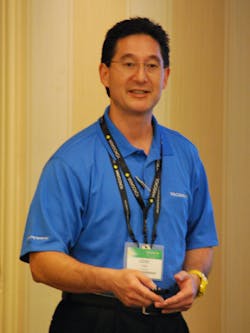For more than one hundred years, Yokogawa has acutely focused on serving its customers, and nowhere is this century-long commitment better demonstrated than in the investments being made in its flagship Centum VigilantPlant (VP) distributed control system (DCS).
"Our users are facing major challenges to achieving operations effectiveness in the areas of safety and security, human reliability, efficiency, and equipment availability and reliability," said Gene Chen, product manager for DCS and safety instrumented systems (SIS) at Yokogawa. "They're focused on productivity, but they need safety systems more than ever; their applications are quickly moving from physical to digital controls; and at the same time, 10,000 Baby Boomers are retiring every day."
"Our users are facing major challenges to achieving operations effectiveness in the areas of safety and security, human reliability, efficiency, and equipment availability and reliability."
To help its customers meet and defeat these challenges, Chen reported that CENTUM VP and its supporting sensors, I/O, networks, ProSafe-RS SIS and other components continue to offer a rock-solid foundation backed up by Yokogawa's deep knowledge in the control and optimization of process applications. "Yokogawa launched the first DCS on the market in 1975, and it's continued to offer progressive compatibility for effectively aging in place," explained Chen. "Yokogawa delivers easy upgradeability that's simple and fast; low complexity and easy expandability; highest proven field reliability with a bulletproof foundation; applications that migrate forward for continued value and reduced lifecycle costs; and knowledgeable engineers to execute, solve your problems, and ensure benefits throughout the solution lifecycle."Chen and his colleagues, Steven Burch, SIS consultant at Yokogawa, and Eugene Spiropoulos, systems solutions architect at Yokogawa, presented "Advances in DCS and SIS" this week at the Yokogawa North American Users Group meeting in Orlando.
Over the past two years, CENTUM VP has progressed quickly from version R6.01 in 2014 to R6.02 in 2015 to this year's release of R6.03. Numerous new capabilities and useful features have been added at each stage. Some of the primary highlights incorporated into and delivered by CENTUM VP include:
- Whole Alarm lifecycle management service, which combines Yokogawa's Alarm Management Solution Suite and its Global Alarm Management Optimization program;
- Conversion of big data floods into useful knowledge by using OPC-UA communication strategy, Yokogawa's data as a service, and its hosted and cloud applications;
- Fire and gas (F&G) applications supported with DCS and SIS faceplates. These are designed to enhance ProSafe-RS as well the CENTUM VP Human Interface Station (HIS), and can handle tasks like detector resets and function blocks for F&G devices;
- Safety Lifecycle Management solution, covering a full range of safety services. Its analysis section handles site assessment, HAZOP facilitation, layers of protection analysis (LOPA) and other tasks. Its realization section has a TÜV-certified execution process, and achieves point-by-point compliance with the IEC 61511 standard. And, its operations section does operations performance and compliance assessments, as well as enterprise functional safety monitoring and override management;
- Platform support for Microsoft Windows 10 and Windows Server 2016 in 2017, and renewed support for its cybersecurity configuration tool for these newer operating systems;
- Incorporation of Trinity Integrated Systems software in ProSafe-RS to prevent unauthorized removal of logic from existing controls;
- Use of iDefine software for system recovery;
- Expanson of HIS (Trend) software's trend graph display period, increased pens from eight to 16 on a single trend view, improved usability of trend pen displaying, and increased trend software blocks from 50 to 99;
- Display of a shelved alarm list and suppressed alarms in CENTUM VP's Consolidated Alarm Management Solution (CAMS);
- Enhanced Automation Design Suite software comparison editor for sequence tables in the DCS's history management tuning parameter;
- Upgraded RIO (remote I/O) system in CENTUM VP R6.03; and
- Unified Gateway Station 2 (UGS2) for seamless monitoring and operating CENTUM subsystems, which includes a 1-second switchover time.








